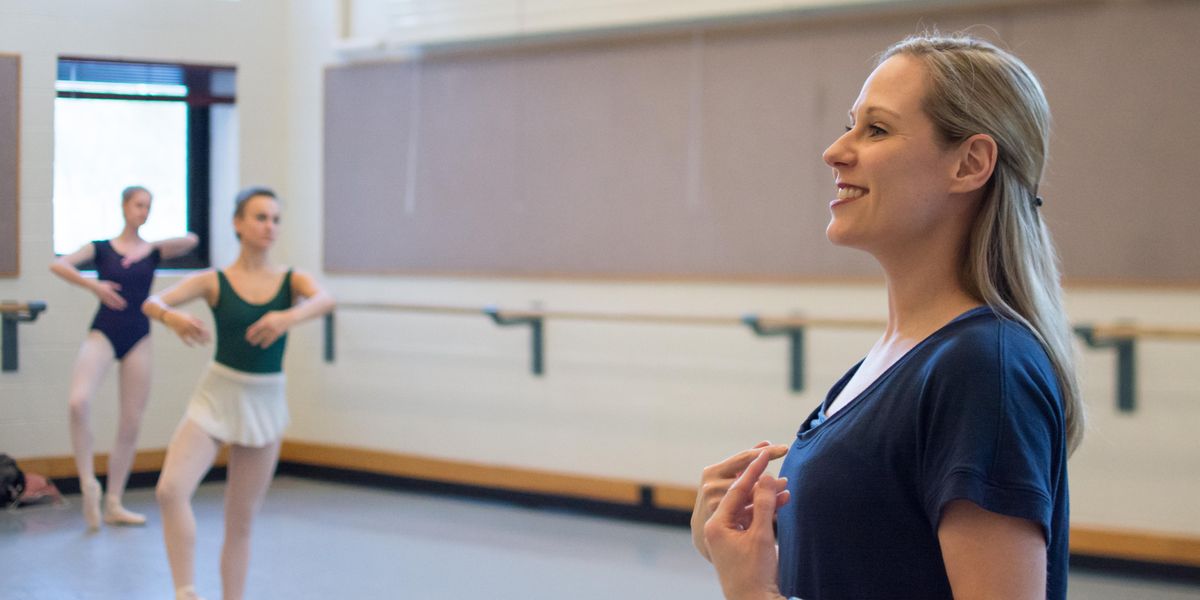How to Make the Most of Corrections—Even If You're Attending Class Virtually
Dancers are taught how to take corrections from their first day in the studio. In fact, some might argue that your ability to apply feedback matters more than how high your développé is or how many pirouettes you can whip out. But how can you go about making yourself a more coachable dancer? Just like your technique, it takes practice. Once you enter a college program, you’re expected to take more ownership of your training and focus on developing your artistry, not just the basics. And today, there’s the added novelty of navigating virtual movement classes.
The Dos & Don’ts
Do write corrections down. “I’m a bit old-school I guess, but I still think taking notes during breaks or after class is great,” says Mila Thigpen, chair of dance at the Boston Conservatory at Berklee. Not only does writing down your corrections help you absorb the information, but it can also serve as a journal. As you progress, you can look back at all the feedback you’ve received.
Don’t take it to heart.
Dancers can sometimes take constructive feedback personally, especially since your body is your instrument. Thigpen asks her students to think of her as a coach rather than a critic. She finds that helps them separate the notes on their work from who they are as a person. And remember, receiving constructive criticism typically means your instructor sees potential in you.
Do ask questions.
Not sure what your professor means by “dig deeper”? Ask! Sometimes it takes a second demonstration or a different phrasing for a correction to click.
Don’t get frustrated.
If you’ve already heard “Keep your shoulders down” 100 times and you’re not even through barre, remember that applying feedback isn’t often instantaneous. It’s all about making it a habit, says Melissa Bobick, assistant professor and ballet program head at the University of Utah. Professors aren’t expecting an immediate change, but they might keep reminding you of a correction until it’s second nature.
Does Going Virtual Change Things?
In our COVID-19 world, it’s easy to mentally check out while taking classes via Zoom. But remember, you’ll get out of class what you put in, says Bobick. Here are a few strategies to stay engaged:
Listen to everyone’s corrections.
One of the benefits of live video classes is that you’ll be able to hear all of the feedback your instructor offers to your peers, and chances are, you can apply it to your own dancing too.
Focus on feeling.
If you’re taking a Zoom class in your dorm room, you probably don’t have the luxury of a mirror. Bobick says this is an excellent opportunity to dial in on how proper alignment and placement feels, rather than how it looks.
Give yourself feedback.
View this time as a chance to take ownership of your training and practice for the professional world, Bobick says. “This is the beginning of that shift for students to be their own teachers.”
Use your hands.
Whether you’re taking in-person or virtual classes, hands-on corrections are likely out of the picture. For tactile learners, Bobick asks them to place their own hands where an instructor might if they were offering a physical correction.
The Two Extremes
When you’re not getting enough: Don’t be afraid to approach your professor—with kindness and respect, of course—if you’d like more corrections in class. Ask if you can set up a time to chat about your progress, and let them know you’re interested in more consistent communication.
Thigpen urges students not to jump to conclusions if they aren’t receiving a lot of corrections. “Sometimes it takes us a while to get to know students, and we want to make space for them to process the feedback that we’re giving,” she says.
If the feedback feels destructive:
There may be times when a professor gives feedback in a way that makes you shut down. If you need to, remove yourself from the situation. Take a bathroom break or step outside. After class, have a conversation with your professor about how the criticism made you feel and ask if it can be rephrased in a more constructive way. Although this conversation can be uncomfortable, it can set a precedent for healthy communication.




